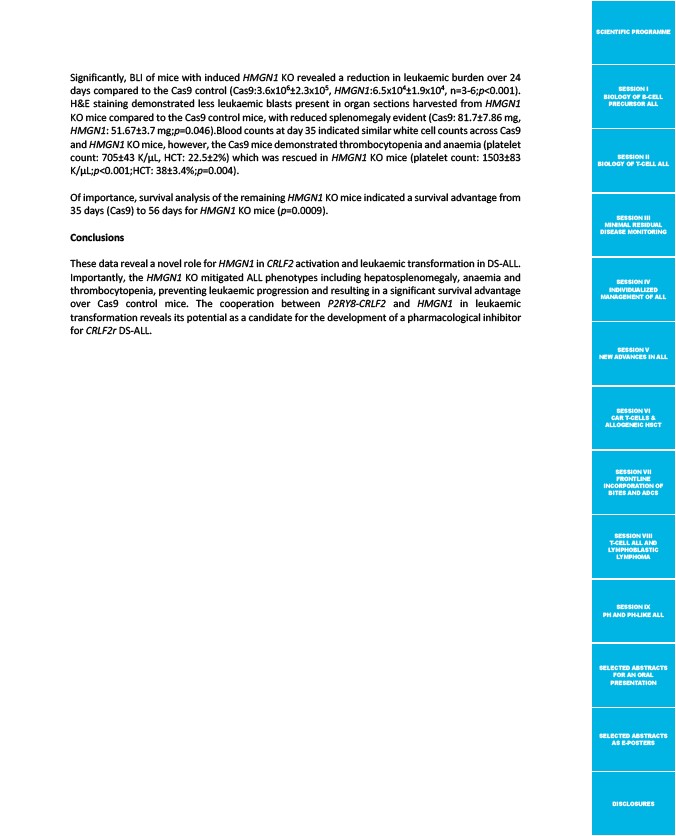
SCIENTIFIC PROGRAMME
SESSION I
BIOLOGY OF B-CELL
PRECURSOR ALL
SESSION II
BIOLOGY OF T-CELL ALL
SESSION III
MINIMAL RESIDUAL
DISEASE MONITORING
SESSION IV
INDIVIDUALIZED
MANAGEMENT OF ALL
SESSION V
NEW ADVANCES IN ALL
SESSION VI
CAR T-CELLS &
ALLOGENEIC HSCT
SESSION VII
FRONTLINE
INCORPORATION OF
BITES AND ADCS
SESSION VIII
T-CELL ALL AND
LYMPHOBLASTIC
LYMPHOMA
SESSION IX
PH AND PH-LIKE ALL
SELECTED ABSTRACTS
FOR AN ORAL
PRESENTATION
SELECTED ABSTRACTS
AS E-POSTERS
DISCLOSURES
Significantly, BLI of mice with induced HMGN1 KO revealed a reduction in leukaemic burden over 24
days compared to the Cas9 control (Cas9:3.6x106±2.3x105, HMGN1:6.5x104±1.9x104, n=3-6;p<0.001).
H&E staining demonstrated less leukaemic blasts present in organ sections harvested from HMGN1
KO mice compared to the Cas9 control mice, with reduced splenomegaly evident (Cas9: 81.7±7.86 mg,
HMGN1: 51.67±3.7 mg;p=0.046).Blood counts at day 35 indicated similar white cell counts across Cas9
and HMGN1 KO mice, however, the Cas9 mice demonstrated thrombocytopenia and anaemia (platelet
count: 705±43 K/μL, HCT: 22.5±2%) which was rescued in HMGN1 KO mice (platelet count: 1503±83
K/μL;p<0.001;HCT: 38±3.4%;p=0.004).
Of importance, survival analysis of the remaining HMGN1 KO mice indicated a survival advantage from
35 days (Cas9) to 56 days for HMGN1 KO mice (p=0.0009).
Conclusions
These data reveal a novel role for HMGN1 in CRLF2 activation and leukaemic transformation in DS-ALL.
Importantly, the HMGN1 KO mitigated ALL phenotypes including hepatosplenomegaly, anaemia and
thrombocytopenia, preventing leukaemic progression and resulting in a significant survival advantage
over Cas9 control mice. The cooperation between P2RY8-CRLF2 and HMGN1 in leukaemic
transformation reveals its potential as a candidate for the development of a pharmacological inhibitor
for CRLF2r DS-ALL.